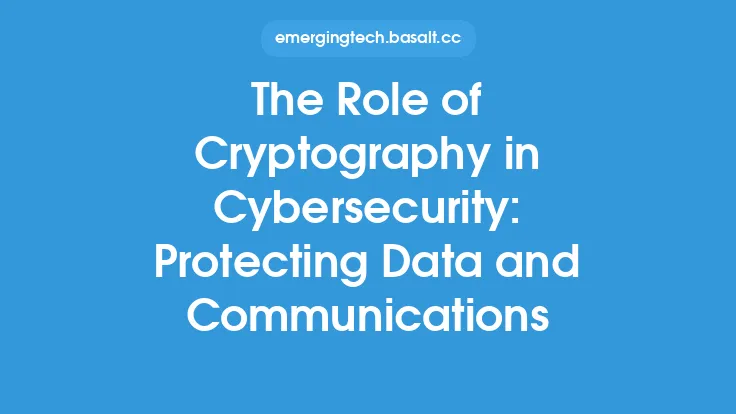In the realm of cryptography, encryption is a crucial aspect of securing data and communications. There are two primary types of encryption: symmetric and asymmetric. Each has its own strengths and weaknesses, and understanding the differences between them is essential for choosing the right approach for a particular use case. Symmetric encryption uses the same key for both encryption and decryption, whereas asymmetric encryption uses a pair of keys: one for encryption and another for decryption.
Symmetric Encryption
Symmetric encryption is a type of encryption where the same key is used for both encryption and decryption. This means that the sender and receiver must share the same secret key in order to encrypt and decrypt the data. Symmetric encryption is generally faster and more efficient than asymmetric encryption, making it suitable for large-scale data encryption. The most common symmetric encryption algorithms include AES (Advanced Encryption Standard), DES (Data Encryption Standard), and Blowfish. Symmetric encryption is widely used in various applications, such as secure web browsing (HTTPS), virtual private networks (VPNs), and disk encryption.
Asymmetric Encryption
Asymmetric encryption, also known as public-key encryption, uses a pair of keys: one for encryption and another for decryption. The encryption key is publicly available, while the decryption key is kept private. This allows anyone to send encrypted data to the owner of the private key, without the need to share the private key. Asymmetric encryption is commonly used for secure communication over the internet, such as secure web browsing (HTTPS) and email encryption. The most common asymmetric encryption algorithms include RSA (Rivest-Shamir-Adleman) and elliptic curve cryptography (ECC). Asymmetric encryption provides a higher level of security than symmetric encryption, but it is generally slower and more computationally intensive.
Key Exchange and Management
One of the main challenges in symmetric encryption is key exchange and management. Since the same key is used for both encryption and decryption, it must be shared securely between the sender and receiver. This can be a complex task, especially in large-scale systems. Asymmetric encryption, on the other hand, provides a secure way to exchange keys, as the public key can be shared openly without compromising the security of the private key. However, key management is still an essential aspect of asymmetric encryption, as the private key must be kept secure to prevent unauthorized access.
Performance and Scalability
Symmetric encryption is generally faster and more efficient than asymmetric encryption, making it suitable for large-scale data encryption. Asymmetric encryption, on the other hand, is more computationally intensive and can be slower. However, the performance difference between symmetric and asymmetric encryption can be mitigated by using hybrid encryption, which combines the strengths of both approaches. Hybrid encryption uses asymmetric encryption to exchange the symmetric key, and then uses symmetric encryption to encrypt the data.
Security Considerations
Both symmetric and asymmetric encryption provide a high level of security, but they have different security considerations. Symmetric encryption is vulnerable to key exchange attacks, where an attacker intercepts the shared key. Asymmetric encryption, on the other hand, is vulnerable to factorization attacks, where an attacker attempts to factorize the large composite number used to generate the public and private keys. Additionally, asymmetric encryption is also vulnerable to quantum computer attacks, which can potentially factorize large composite numbers efficiently.
Choosing the Right Approach
Choosing the right encryption approach depends on the specific use case and requirements. Symmetric encryption is suitable for large-scale data encryption, where speed and efficiency are essential. Asymmetric encryption, on the other hand, is suitable for secure communication over the internet, where a high level of security is required. Hybrid encryption, which combines the strengths of both approaches, is also a popular choice. Ultimately, the choice of encryption approach depends on the specific security requirements, performance constraints, and scalability needs of the application.
Real-World Applications
Both symmetric and asymmetric encryption have numerous real-world applications. Symmetric encryption is widely used in secure web browsing (HTTPS), virtual private networks (VPNs), and disk encryption. Asymmetric encryption is commonly used in secure email encryption, digital signatures, and online transactions. Hybrid encryption is used in various applications, such as secure socket layer/transport layer security (SSL/TLS) and IPsec (Internet Protocol Security). Understanding the differences between symmetric and asymmetric encryption is essential for choosing the right approach for a particular use case and ensuring the security and integrity of data and communications.
Future Developments
The field of cryptography is constantly evolving, with new developments and advancements in encryption algorithms and techniques. The rise of quantum computing, for example, has significant implications for cryptography, as it can potentially factorize large composite numbers efficiently. As a result, there is a growing need for quantum-resistant encryption algorithms, such as lattice-based cryptography and code-based cryptography. Additionally, the development of homomorphic encryption, which allows computations to be performed on encrypted data, has the potential to revolutionize the way we approach data security and privacy. As the field of cryptography continues to evolve, it is essential to stay informed about the latest developments and advancements in encryption algorithms and techniques.





